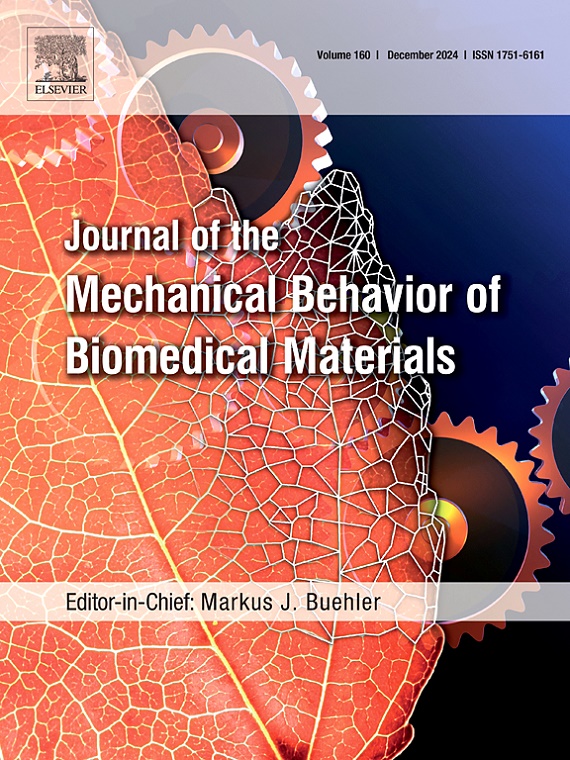Confined and unconfined articular cartilage mechanics: Effect of creep duration on estimations of mechanical properties
IF 3.3
2区 医学
Q2 ENGINEERING, BIOMEDICAL
Journal of the Mechanical Behavior of Biomedical Materials
Pub Date : 2025-03-21
DOI:10.1016/j.jmbbm.2025.106982
引用次数: 0
Abstract
Recent findings suggest that cartilage mechanical function may be a biomarker for early osteoarthritis (OA) pathology. Thus, the development of methodologies for in-vivo applications has expanded. However, when creep tests are performed, inconsistency in applied stress and testing duration impede meaningful comparisons. Therefore, this study investigates the impact of creep duration on cartilage mechanics through ex-vivo confined and unconfined compression experiments on healthy bovine cartilage samples (n = 20), subjected to 1 MPa stress for 5 h. A Zener model was fitted to unconfined data and a nonlinear biphasic model was fitted to confined data using durations ranging from 15 min to 5 h. Mechanical properties were compared against the full 5-h dataset to determine relative errors (RE) associated with insufficient creep duration. Based on our findings, we aim to establish a common ground for both in vivo and ex vivo environments. Both unconfined (R2 = 0.96 ± 0.02) and confined (R2 = 0.997 ± 0.003) models fitted the data well over 5 h. For confined creep tests, the aggregate modulus (HA) was 0.34 ± 0.12 MPa after 5 h and 0.27 ± 0.12 MPa after 1 h (RE ∼ 20 %), while initial permeability (k0) increased from 0.17 × 10−15 m4N−1s−1 to 0.56 × 10−15 m4N−1s−1 (RE ∼ 49 %). The Zener model estimated the initial (E1) and steady-state (E2) modulus to be 3.6 ± 0.7 MPa and 3.2 ± 0.3 MPa after 5 h, respectively. After 1 h, these values were 4.7 ± 1.0 MPa (RE ∼ 29 %) and 3.2 ± 0.3 MPa (RE ∼ 2 %). A larger RE (∼57 %) was observed for the relaxation time constant (τ) determined after 5 h (1688 ± 556 s) and 1 h (781 ± 170 s) with the Zener model. The benefit of extended creep duration diminished after 1–1.5 h for confined compression and 2 h for unconfined compression for non-rate dependent stiffness parameters (i.e., HA, E1, E2). This aligned well with the predefined equilibrium criteria of less than 0.6 μm/min, with equilibrium reached at 71 ± 23 min for confined experiments and 94 ± 25 min for unconfined experiments. In contrast, for parameters controlling the nonlinear material response (i.e., τ, k0, M), 4 h were required for unconfined compression and 1.5 h for confined compression to achieve RE ∼ 10 %. Thus, insufficient creeping duration resulted in large RE, especially for strain-dependent parameters. Therefore, it is recommended to use a clear equilibrium definition when conducting ex vivo experiments. In the context of clinically viable testing duration (i.e., 45–60 min) RE was ∼20 % for the predicted aggregate modulus and ∼10 % for the nonlinear permeability coefficient. While these errors appear substantial, they may still estimate cartilage mechanics within reasonable limits given the associated variability in healthy and OA cartilage characteristics. Therefore, within a limited timeframe, it could be possible to estimate mechanical properties using in vivo creep experiments that may serve as biomarkers for early OA.

约束和非约束关节软骨力学:蠕变持续时间对力学性能估计的影响
最近的研究结果表明,软骨力学功能可能是早期骨关节炎(OA)病理的生物标志物。因此,体内应用方法的发展已经扩大。然而,在进行蠕变试验时,施加应力和试验持续时间的不一致阻碍了有意义的比较。因此,本研究通过健康牛软骨样品(n = 20)的离体约束和无约束压缩实验,研究蠕变持续时间对软骨力学的影响。在15分钟至5小时的持续时间内,将齐纳模型拟合到无约束数据中,非线性双相模型拟合到有约束数据中。将力学性能与完整的5小时数据集进行比较,以确定与蠕变持续时间不足相关的相对误差(RE)。基于我们的发现,我们的目标是为体内和体外环境建立一个共同的基础。无约束(R2 = 0.96±0.02)和密闭(R2 = 0.997±0.003)模型在5小时内都能很好地拟合数据。对于密闭蠕变试验,5小时后骨料模量(HA)为0.34±0.12 MPa, 1小时后为0.27±0.12 MPa (RE ~ 20%),而初始渗透率(k0)从0.17 × 10−15 m4N−1s−1增加到0.56 × 10−15 m4N−1s−1 (RE ~ 49%)。Zener模型估计5 h后初始(E1)和稳态(E2)模量分别为3.6±0.7 MPa和3.2±0.3 MPa。1小时后,这些值分别为4.7±1.0 MPa (RE∼29%)和3.2±0.3 MPa (RE∼2%)。用Zener模型在5 h(1688±556 s)和1 h(781±170 s)后测定的弛豫时间常数(τ)有较大的RE(~ 57%)。对于非速率相关的刚度参数(即HA, E1, E2),在1-1.5 h的有侧限压缩和2 h的无侧限压缩后,延长蠕变持续时间的好处减少。实验结果表明,在密闭条件下的平衡时间为71±23 min,在无密闭条件下的平衡时间为94±25 min。相比之下,对于控制非线性材料响应的参数(即τ, k0, M),无侧限压缩需要4 h,有侧限压缩需要1.5 h,才能达到RE ~ 10%。因此,蠕变持续时间不足导致较大的RE,特别是对于应变相关参数。因此,在进行离体实验时,建议使用一个明确的平衡定义。在临床可行的测试时间(即45-60分钟)的背景下,预测的聚合模量的RE为~ 20%,非线性渗透系数的RE为~ 10%。虽然这些误差看起来很大,但考虑到健康和OA软骨特征的相关变异性,它们仍然可以在合理的范围内估计软骨力学。因此,在有限的时间内,可以使用体内蠕变实验来估计机械性能,这可能作为早期OA的生物标志物。
本文章由计算机程序翻译,如有差异,请以英文原文为准。
求助全文
约1分钟内获得全文
求助全文
来源期刊

Journal of the Mechanical Behavior of Biomedical Materials
工程技术-材料科学:生物材料
CiteScore
7.20
自引率
7.70%
发文量
505
审稿时长
46 days
期刊介绍:
The Journal of the Mechanical Behavior of Biomedical Materials is concerned with the mechanical deformation, damage and failure under applied forces, of biological material (at the tissue, cellular and molecular levels) and of biomaterials, i.e. those materials which are designed to mimic or replace biological materials.
The primary focus of the journal is the synthesis of materials science, biology, and medical and dental science. Reports of fundamental scientific investigations are welcome, as are articles concerned with the practical application of materials in medical devices. Both experimental and theoretical work is of interest; theoretical papers will normally include comparison of predictions with experimental data, though we recognize that this may not always be appropriate. The journal also publishes technical notes concerned with emerging experimental or theoretical techniques, letters to the editor and, by invitation, review articles and papers describing existing techniques for the benefit of an interdisciplinary readership.
 求助内容:
求助内容: 应助结果提醒方式:
应助结果提醒方式:


